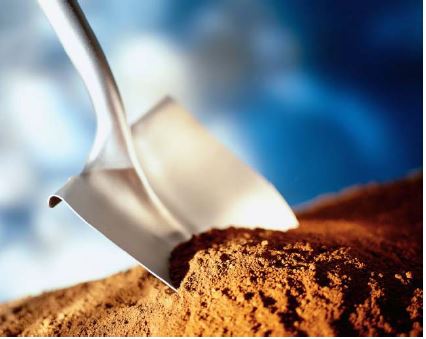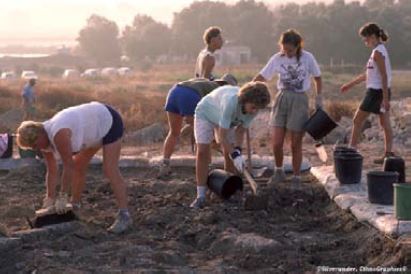What is a soil test?
A soil test analyzes a representative sample of soil for specific characteristics. Most soil tests use chemical measurements and models to estimate the amount of nutrients that are available for growing plants.
A soil test can measure other chemical characteristics of a soil such as the salt levels, organic matter or decomposed plant-carbon material and the soil pH in the soil (which influences the availability of nutrients to plants). Soil texture is usually determined by hand and indicates the proportions of sand, silt and clay which influence water retention, infiltration and availability for plants.
When the soil test results are sent to the grower, the lab usually provide an interpretation of the results. The test results will indicate when soil characteristics have levels outside of normal ranges and what could be done to improve the soil.


How do I take a soil sample?
Soil sampling is usually done in late fall just before the soil freezes or in early spring before the growing season. Avoid taking soil samples within a month of fertilization with chemical or organic fertilizers.
Collect 10 - 15 soil samples from different locations throughout the growing area. Take each sample of soil from the soil depths where most of the plant’s roots grow (usually in the top 2 - 12 inches). Mix the samples into one combined sample. If the plants in part of the area are growing differently, you need to sample and test the differing areas separately.
Follow the steps recommended by the lab to which you are sending the sample. The lab will determine the amount of soil needed (usually 1 - 2 cups) and whether to air dry the sample before it is sent. If a soil sample has gotten very hot or been through extreme temperature changes, it is best to get a new sample of soil for testing.
Why and how often to do a soil test?
A soil test can help a plant grower determine whether an area of ground has enough available nutrients for good plant growth. A soil test can also help growers determine the potential for sodium (salinity), pH, organic matter level and texture effects on plant growth.
The levels of phosphorus (P), potassium (K) and micronutrients available for plants do not change rapidly in soils. A test for these is only needed about every five years unless the soil has had substantial additions such as compost, manure or fertilizer that are likely to change the levels P, K and micronutrients.
Nitrogen (N) and sulfur (S) are critically important for plant growth but the amounts can change rapidly in the soil. Accordingly, soil tests for those nutrients are sometimes done yearly. If the plants grown use large amounts of nutrients, fertilizer can be added to the soil to address the full nutrient requirement and forego the soil test.
What does a soil test not measure?
A basic soil test will not measure some variables that can adversely affect plant growth. These include chemical residues (i.e. pesticides, toxic chemicals), disease and insect infestations or poor physical characteristics of the soil. Soil tests do not measure factors such as light conditions, water quality and water quantity.
The quality of irrigation water should be tested to ensure that it is not a source of sodium or other minerals which can negatively impact plant growth.
A general soil test won’t provide information on the soil biology such as the bacteria, fungi, worms, insect and other living organisms that benefit the soil. Specialty test labs can provide this analysis.
A soil test will generally not tell the total amount nutrients present in the soil since some are not in a form available for plants. The soil test estimates the amount of nutrients available for plant roots to absorb. Because the availability of nutrients varies due to environment and soil types, it is important to use a soil test that is calibrated for your growing area. Adding organic matter such as composted manure or grass and leaf litter often greatly improves desert soils and makes nutrients more available to plants.
What types of soil tests are best?
Most of the do-it-at-home soil test kits are not suitable for testing Nevada soils. These tests are inaccurate for our high pH and saline soil conditions. Many of these tests are developed for acid pH soil types found in the eastern states.
The most accurate results are provided from properly sampled soil that is sent to a quality soil test lab that is regularly testing desert soils.
Where can you get soil testing done?
Accredited soil testing labs located near Nevada:
- Utah State University Extension USU Analytical lab Ag Science Rm166 Logan, UT 843222-4830 Phone 435-797-2217 Fax 435-797-2117
- Utah State University Extension Website
- A& L Western Laboratories Inc. 1311 Woodland Avenue Suite 1 Modesto, CA 95351 Phone: (209) 529-4080 Fax: (209) 529-4736
- A& L Western Laboratories Inc. Website
- Analytical Sciences Laboratory University of Idaho Holm Research Center Moscow, ID 83844-2203 Phone: 208-885-7900 Fax: 208-885-8937
- Analytical Sciences Laboratory Website
- Western Laboratories 211 Highway 95 Parma, ID 83660 208-722-6564
- Western Laboratories Website
Bibliography
- Soil Testing Guide for Home Gardens. Duane Hatch. Utah State University Extension. Horticulture Fact Sheet 05. 1990. HG/H05.
- Soil Testing. University of Rhode Island Green Share Factsheets.


